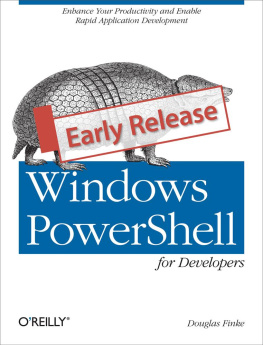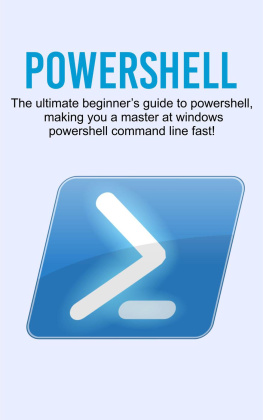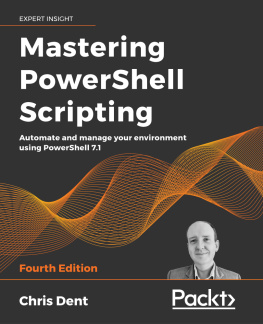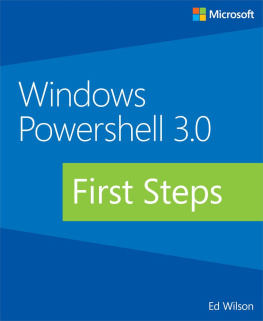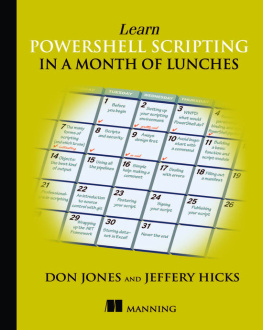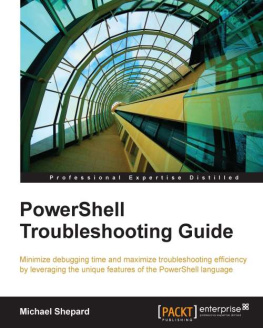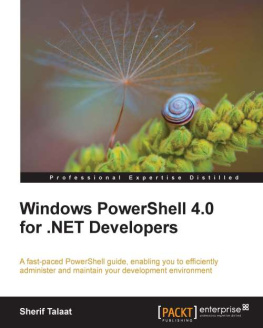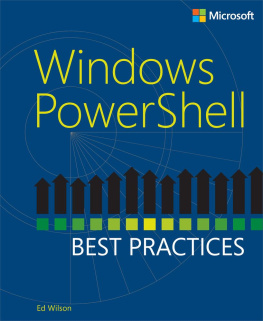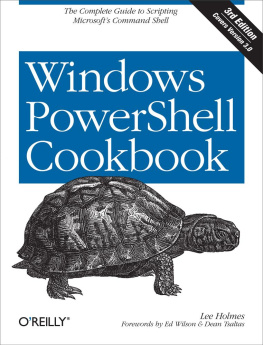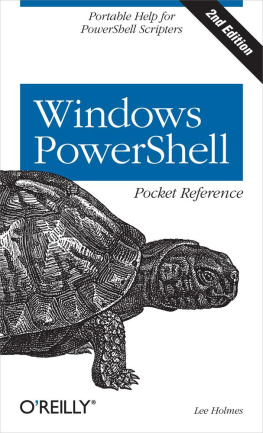This book is not a beginners guide to PowerShell. If you are an experienced developer or IT pro, this book gives you insight into what PowerShell can do.
The examples in this book are runnable out of the box. You can study how and what the scripts dothis is one of the tried-and-true ways of learning a new paradigm. While some examples include C# .NET, it is not required that you understand C#.
The examples are self-contained. Run them; see what they do. Then you can pull them apart, tweak them, and incorporate them into your PowerShell and .NET solutions.
Contents of This Book
gives an overview of the platform and answers the question Why PowerShell?
steps you through getting PowerShell prepped for running.
offers a walkthrough of things you probably didnt even know the PowerShell platform could do.
covers writing a template engine and using the new PowerShell v3 abstract syntax tree interface to extract information from PowerShell scripts.
kicks it up a notch and shows you how easy it is to provide scripting abilities for your C# (WPF) apps by embedding PowerShell into them.
demonstrates PowerShells excellent capabilities for working with the Internet. JSON, XML, HTTP, Twitter? No problem.
demonstrates how PowerShell is based on .NET. Want to build GUIs with less code? This is the chapter for you.
further explores PowerShells relationship to .NET and shows you how to leverage this seamless integration with other Microsoft frameworks.
covers one of my favorite topicsbuilding little languagesand shows how PowerShell makes this easy. Whether you prefer domain-specific languages (DSL) or domain-specific vocabularies (DSV), youll want to check out what PowerShell has to offer.
shows you how to really leverage applications like Microsoft Excel and by extension, Microsoft COM (Component Object Model) applications.
is an excursion through some of the new and exciting features of PowerShell v3, set to ship with Windows 8 and Windows Server 2012, and available in beta for Windows 7.
is all about programmer productivity. This is a PowerShell sweet spot, and this chapter shows you how to get the most out of the platform.
shows you how to enable PowerShell v2 to load and work with .NET 4.0 DLLs. This is the default mode in PowerShell v3.
Conventions Used in This Book
The following typographical conventions are used in this book:
Plain text
Indicates menu titles, menu options, menu buttons, and keyboard accelerators (such as Alt and Ctrl).
ItalicIndicates new terms, URLs, email addresses, filenames, file extensions, pathnames, directories, and Unix utilities.
Constant widthIndicates commands, options, switches, variables, attributes, keys, functions, types, classes, namespaces, methods, modules, properties, parameters, values, objects, events, event handlers, XML tags, HTML tags, macros, the contents of files, or the output from commands.
Constant width boldShows commands or other text that should be typed literally by the user.
Constant width italicShows text that should be replaced with user-supplied values.
Note
This icon signifies a tip, suggestion, or general note.
Warning
This icon indicates a warning or caution.
Using Code Examples
This book is here to help you get your job done. In general, you may use the code in this book in your programs and documentation. You do not need to contact us for permission unless youre reproducing a significant portion of the code. For example, writing a program that uses several chunks of code from this book does not require permission. Selling or distributing a CD-ROM of examples from OReilly books does require permission. Answering a question by citing this book and quoting example code does not require permission. Incorporating a significant amount of example code from this book into your products documentation does require permission.
We appreciate, but do not require, attribution. An attribution usually includes the title, author, publisher, and ISBN. For example: PowerShell for Developers by Douglas Finke (OReilly). Copyright 2012 Douglas Finke, 978-1-4493-2270-0.
If you feel your use of code examples falls outside fair use or the permission given above, feel free to contact us at .
Available for Download
The code examples in the following chapters are available for download from GitHub at https://github.com/dfinke/powershell-for-developers.
Wed Like to Hear from You
Please address comments and questions concerning this book to the publisher:
| OReilly Media, Inc. |
| 1005 Gravenstein Highway North |
| Sebastopol, CA 95472 |
| (800) 998-9938 (in the United States or Canada) |
| (707) 829-0515 (international or local) |
| (707) 829-0104 (fax) |
We have a web page for this book, where we list errata, examples, and any additional information. You can access this page at:
| http://oreilly.com/catalog/9781449322700 |
To comment or ask technical questions about this book, send email to:
For more information about our books, courses, conferences, and news, see our website at http://www.oreilly.com.
Find us on Facebook: http://facebook.com/oreilly
Follow us on Twitter: http://twitter.com/oreillymedia
Watch us on YouTube: http://www.youtube.com/oreillymedia
Safari Books Online
Safari Books Online is an on-demand digital library that lets you easily search over 7,500 technology and creative reference books and videos to find the answers you need quickly.
With a subscription, you can read any page and watch any video from our library online. Read books on your cell phone and mobile devices. Access new titles before they are available for print, and get exclusive access to manuscripts in development and post feedback for the authors. Copy and paste code samples, organize your favorites, download chapters, bookmark key sections, create notes, print out pages, and benefit from tons of other time-saving features.

